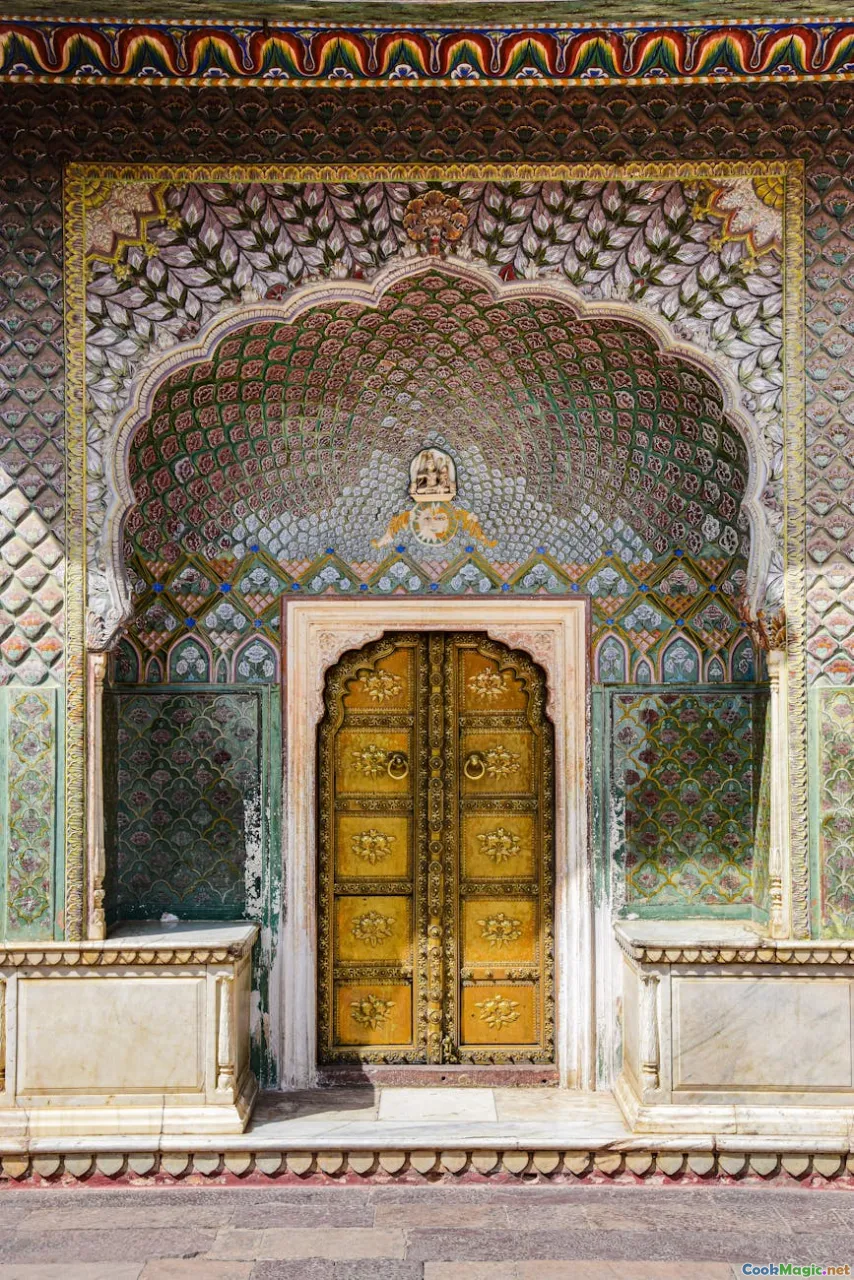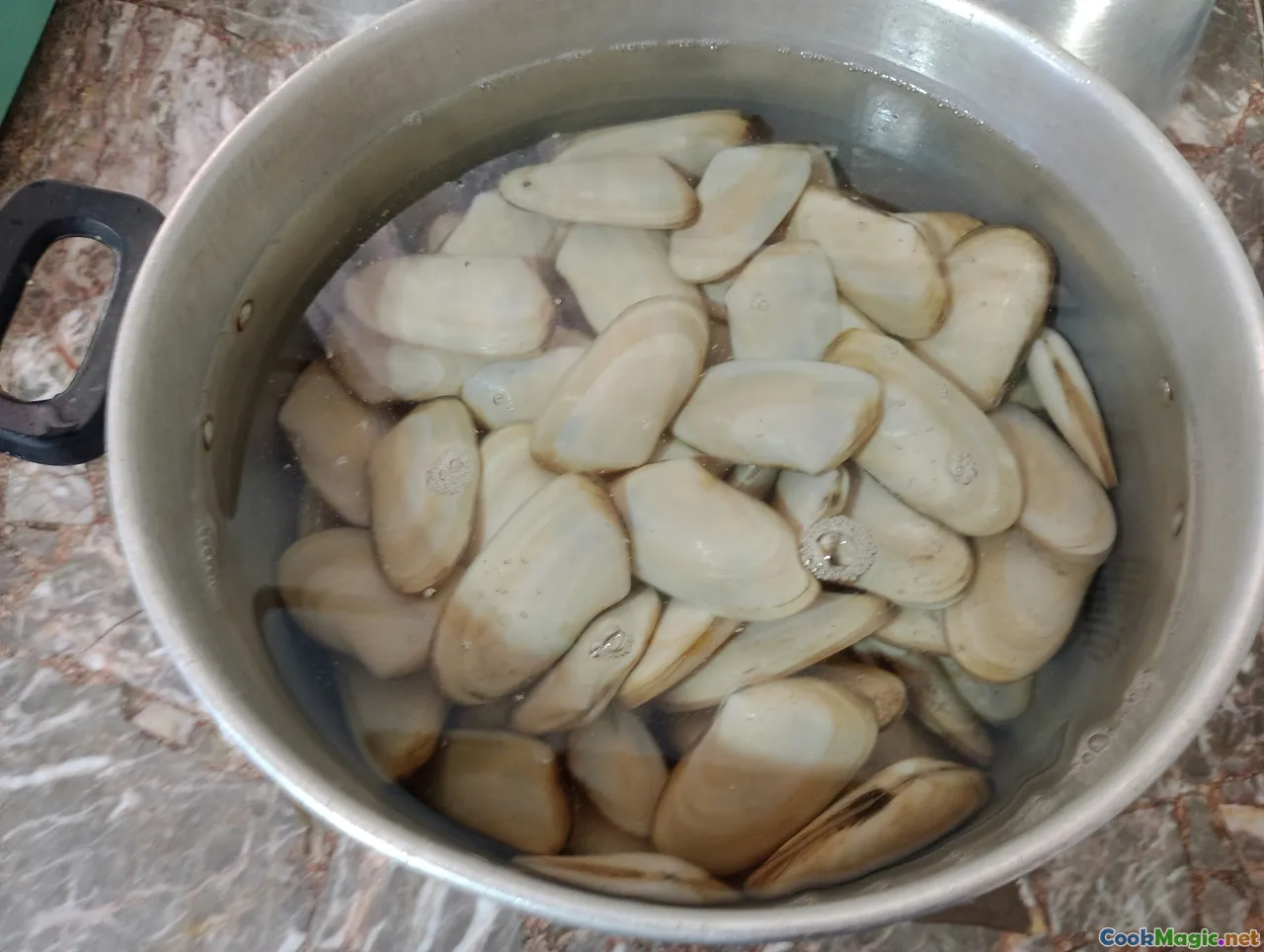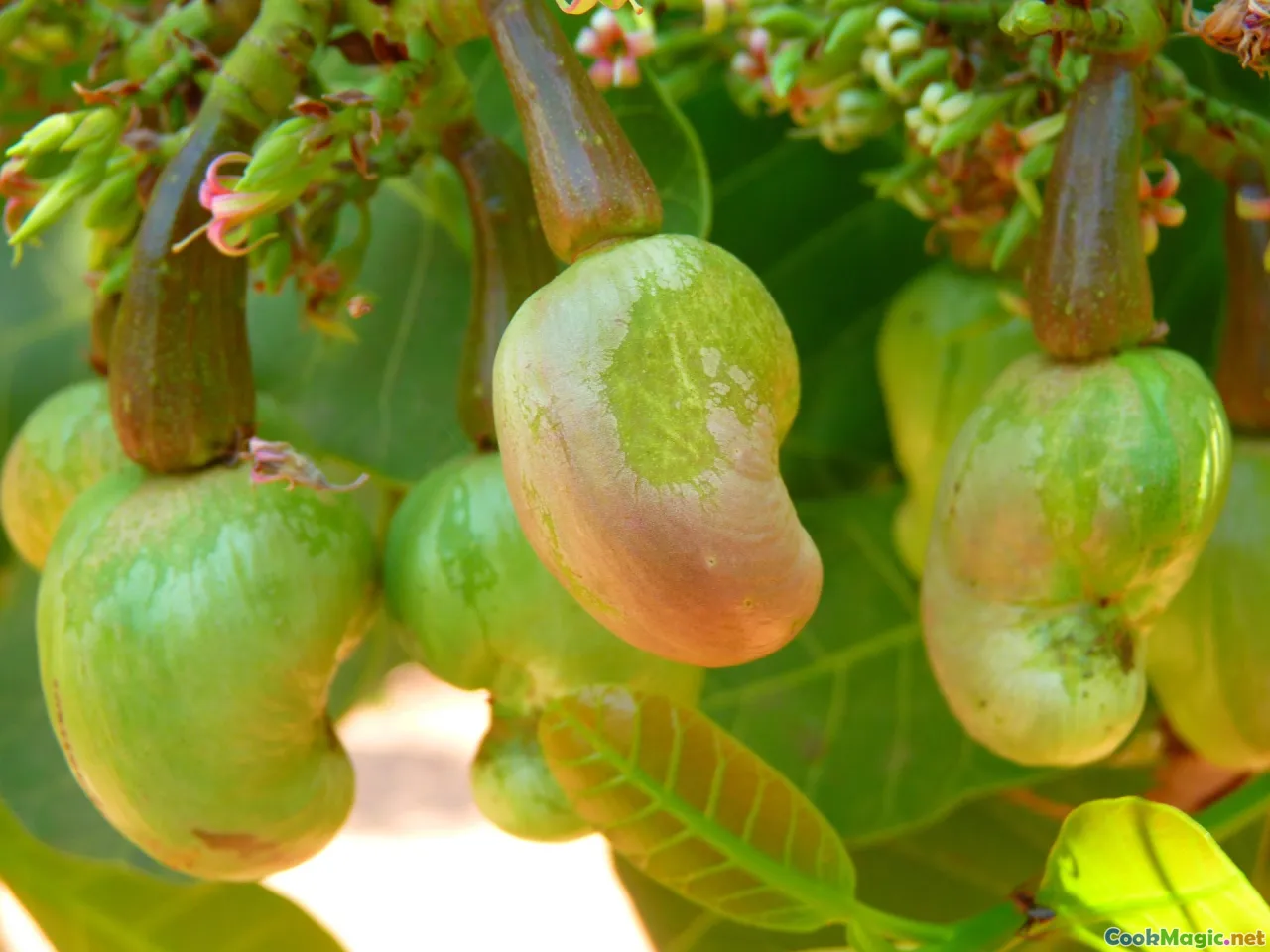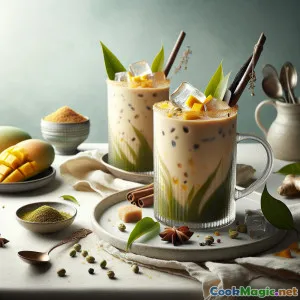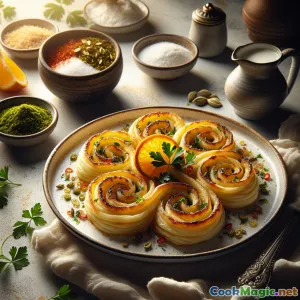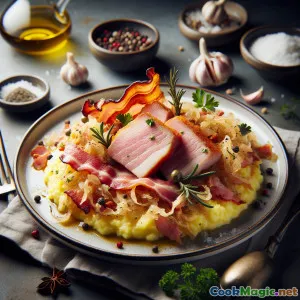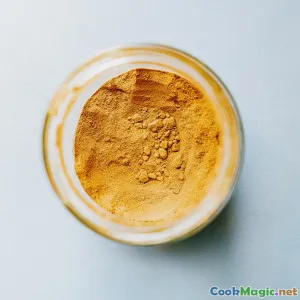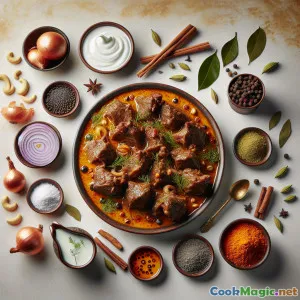
Royaler Rajasthani Weißes Lammcurry Enthüllt
(Royal Rajasthani White Mutton Curry Unveiled)
(0 Bewertungen)0
770
Juli 17, 2025
Problem melden
Zutaten
-
600 grams Lamm (mit Knochen)
(Bitten Sie um Stücke mittlerer Größe; verwenden Sie, sofern möglich, Bio-Produkte.)
-
2 medium Zwiebelpaste
(Weiße Zwiebeln bevorzugt, fein püriert.)
-
60 grams Cashewkerne
(Einweichen und zu einer glatten Paste mahlen.)
-
20 grams Mohnsamen
(Eingeweicht und gemahlen, wird großzügig in königlichen Saucen verwendet.)
-
120 grams Frischer Joghurt
(Vollfette Sahne, gut aufgeschlagen.)
-
3 tbsp Ghee (geklärte Butter)
(Authentischer Geschmack; man kann 1 EL durch Öl ersetzen.)
-
4 pieces Grüne Kardamomkapseln
-
3 pieces Nelken
-
1 inch piece Zimtstange
-
6 pieces Schwarze Pfefferkörner
-
1 piece Lorbeerblatt
-
2 tbsp Ingwer-Knoblauch-Paste
(Frisch, idealerweise hausgemacht.)
-
100 ml Milch
(Verleiht Cremigkeit.)
-
1 tsp Weißer Pfefferpulver
(Zum Erhitzen ohne Farbveränderung.)
-
1 pinch Muskatnuss
(Frisch gerieben, optional aber empfohlen.)
-
1 tsp Kewra-Wasser
(Für eine duftende, blumige Note; Rosenwasser kann als Ersatz dienen.)
Salz, to taste
-
2 tbsp Frische Sahne
(Für den letzten Schliff.)
-
2 sheets Silberblatt (varq)
(Für königliche Garnitur. Falls nicht verfügbar, weglassen.)
-
1 tbsp Frische Korianderblätter
( Fein gehackt, zum Garnieren.)
(Bitten Sie um Stücke mittlerer Größe; verwenden Sie, sofern möglich, Bio-Produkte.)
(Weiße Zwiebeln bevorzugt, fein püriert.)
(Einweichen und zu einer glatten Paste mahlen.)
(Eingeweicht und gemahlen, wird großzügig in königlichen Saucen verwendet.)
(Vollfette Sahne, gut aufgeschlagen.)
(Authentischer Geschmack; man kann 1 EL durch Öl ersetzen.)
(Frisch, idealerweise hausgemacht.)
(Verleiht Cremigkeit.)
(Zum Erhitzen ohne Farbveränderung.)
(Frisch gerieben, optional aber empfohlen.)
(Für eine duftende, blumige Note; Rosenwasser kann als Ersatz dienen.)
(Für den letzten Schliff.)
(Für königliche Garnitur. Falls nicht verfügbar, weglassen.)
( Fein gehackt, zum Garnieren.)
Nährwerte
- Portionen: 4
- Portionsgröße: 1 Schüssel (250g)
- Calories: 550 kcal
- Carbohydrates: 21 g
- Protein: 32 g
- Fat: 37 g
- Fiber: 2.5 g
- Sugar: 6 g
- Sodium: 740 mg
- Cholesterol: 110 mg
- Calcium: 140 mg
- Iron: 3.2 mg
Anweisungen
-
1 - Hammelfleisch säubern und vorbereiten:
Waschen Sie die Lammstücke gründlich und tupfen Sie sie trocken. Legen Sie sie beiseite. Beginnen Sie damit, Mohnsamen und Cashewkerne in lauwarmem Wasser einzuweichen, um eine Paste zu erhalten.
-
2 - Pasten mischen:
Die eingeweichten Cashewkerne und Mohnsamen zu einer glatten Paste mahlen, bei Bedarf etwas Wasser verwenden. Getrennt die weißen Zwiebeln pürieren.
-
3 - Ganze Gewürze anbraten:
Erhitze Ghee in einer schweren Pfanne. Füge Kardamom, Nelken, Zimt, schwarzen Pfeffer und Lorbeerblätter hinzu. Lass sie zischen, bis sie aromatisch duften.
-
4 - Zwiebel-Joghurt-Mischung:
Fügen Sie Zwiebelpaste hinzu, kochen Sie sanft, bis das Aroma milder wird und die Mischung durchsichtig wird. Fügen Sie Ingwer-Knoblauch-Paste hinzu und braten Sie sie leicht goldbraun. Rühren Sie Joghurt unter und kochen Sie bei niedriger Hitze, bis sich das Öl absetzt.
-
5 - Bräune das Hammelfleisch und versiegel es:
Gib Hammelfleischstücke in die Pfanne, brate sie bei starker Hitze einige Minuten an, bis sie rundherum braun sind.
-
6 - Fügen Sie Nuss-Pasten und Gewürze hinzu:
Rühren Sie die Cashew- und Mohnsamenpaste, Salz, weißen Pfeffer und eine Prise Muskatnuss ein. Lassen Sie alles 5–6 Minuten bei niedriger Hitze verbinden.
-
7 - Lass es köcheln, bis es perfekt ist.:
Gießen Sie Milch hinein und etwa 1,5 Tassen Wasser. Decken Sie ab und kochen Sie bei schwacher Hitze 50–60 Minuten, bis das Hammelfleisch zart schmilzt und die Soße dick wird.
-
8 - Vervollständigungen:
Schalten Sie die Hitze aus. Rühren Sie die Sahne ein und geben Sie vorsichtig das Kewra-Wasser dazu, damit es duftet. Schmecken Sie mit Salz ab.
-
9 - Garnieren und Servieren:
Mit einem Löffel in ein Serviergericht geben, glitzernde Silberblätter auslegen und gehackten Koriander darüber streuen. Heiß servieren, dazu Sheermal oder aromatischen Reis reichen.
Waschen Sie die Lammstücke gründlich und tupfen Sie sie trocken. Legen Sie sie beiseite. Beginnen Sie damit, Mohnsamen und Cashewkerne in lauwarmem Wasser einzuweichen, um eine Paste zu erhalten.
Die eingeweichten Cashewkerne und Mohnsamen zu einer glatten Paste mahlen, bei Bedarf etwas Wasser verwenden. Getrennt die weißen Zwiebeln pürieren.
Erhitze Ghee in einer schweren Pfanne. Füge Kardamom, Nelken, Zimt, schwarzen Pfeffer und Lorbeerblätter hinzu. Lass sie zischen, bis sie aromatisch duften.
Fügen Sie Zwiebelpaste hinzu, kochen Sie sanft, bis das Aroma milder wird und die Mischung durchsichtig wird. Fügen Sie Ingwer-Knoblauch-Paste hinzu und braten Sie sie leicht goldbraun. Rühren Sie Joghurt unter und kochen Sie bei niedriger Hitze, bis sich das Öl absetzt.
Gib Hammelfleischstücke in die Pfanne, brate sie bei starker Hitze einige Minuten an, bis sie rundherum braun sind.
Rühren Sie die Cashew- und Mohnsamenpaste, Salz, weißen Pfeffer und eine Prise Muskatnuss ein. Lassen Sie alles 5–6 Minuten bei niedriger Hitze verbinden.
Gießen Sie Milch hinein und etwa 1,5 Tassen Wasser. Decken Sie ab und kochen Sie bei schwacher Hitze 50–60 Minuten, bis das Hammelfleisch zart schmilzt und die Soße dick wird.
Schalten Sie die Hitze aus. Rühren Sie die Sahne ein und geben Sie vorsichtig das Kewra-Wasser dazu, damit es duftet. Schmecken Sie mit Salz ab.
Mit einem Löffel in ein Serviergericht geben, glitzernde Silberblätter auslegen und gehackten Koriander darüber streuen. Heiß servieren, dazu Sheermal oder aromatischen Reis reichen.
Mehr über: Royaler Rajasthani Weißes Lammcurry Enthüllt
Safed Maas Sheherwali Style: A Regal Heritage on Every Plate
Introduction & History
Safed Maas Sheherwali Style is not simply a dish; it epitomizes the confluence of Rajasthani royalty and unique Sheherwali Jain cultural influences that thrived in Murshidabad—once Bengal's seat of power and multicultural splendor. Traditionally, 'Safed Maas' in Rajasthan signifies a mutton curry solely bathed in white gravies, eschewing red chilies and vibrant spice blends for slivers of subtlety and aromatics. The Sheherwali community, celebrated for their mercantile nous and discerning finesse, reflected their regal opulence in banquets interwoven with Mughal and Marwari essence.
What Sets Sheherwali Safed Maas Apart?
This rendition’s reverent homage to timeless princely kitchens lies in its orchestral balance: a medley of nuts—cashew and poppy seed paste—enrich the velvety gravy, harmonizing with mellow yogurt, floral spices, and an occasional kiss of rose. Unlike the fiery red gravies, this one seeks a gentle elegance, letting the tender mutton and creamy sauce sing. What truly distinguishes the Sheherwali style is:
- Refusal to use regular red chili, turmeric, or harsh garam masala.
- Joyous embrace of mild white pepper, aromatics, nuts, and flower essences.
- Frequent use of a touch of floral (often kewra or rose) water for fragrant finish.
- Optional application of shimmering silver leaf (‘varq’) for special feasts.
Cooking Secrets, Tips, & Personal Notes
Meat Selection: How the mutton is cut matters. Choose pieces with bone—the slow, hour-long simmer is what yields a gravy bursting with flavor and the supremely tender characteristic of no-nonsense regal curries.
Cashew-Poppy Paste: Ensure both nuts and seeds are soaked for at least half an hour to ensure smoothest grinding. A fine, velvety paste prevents grittiness in that prized white gravy.
The Aromatic Difference: Frying whole spices in ghee initiates the dish’s symphony. Control the flame and sauté aromatics gently to repel bitterness from onions and garlic.
Milk & Yogurt Marriage: To master a shamelessly lush yet subtle sauce, you must balance milk and yogurt, whisking slowly into the base to avoid curdling.
Garnishing with Class: For formal occasions, delicate sheets of edible silver leaf leave a striking impression and hint at the aristocratic table.
Accompaniments: Sheherwali Safed Maas is customarily enjoyed with sheermal (sweet saffron flatbread), soft naans, or plain fragrant basmati. When seeking contrast, jeera rice punctuates the meal’s richness.
If you crave a vegetarian tweak, simply substitute paneer chunks or boiled potatoes and use the core technique.
Cultural Significance
Though Sheherwali cuisine for the most part follows Jain vegetarian laws, at grand social functions or interactions with the Rajasthani nobility, such royal celebratory non-veg dishes were nuanced for a gentle, extravagant palate. Carefully balanced spices and an absence of overbearance honor ancient codes of hospitality, appeasing both privilege and probity. They stand as a testament to the meld of Jain thought, royal opulence, and Mughal artistry.
Final Musings & Aspects
If you seek to wow guests with an unforgettable feast in a velvet white, this dish will become a party centerpiece. It’s a paean to delicate flavors over unrestrained heat. Its silken texture—lavished with nuts and milk—soothes, yet leaves a savory trailing note, gently coaxed upward by keora’s floral finish.
For best results:
- commit to slow-cooking;
- be gentle when adding milk or yogurt;
- don’t skip the little musk of nutmeg or the sweet floral note at the end.
Whether for a winter gathering or a festive thali, Safed Maas Sheherwali Style will transport your table across time, drawing every guest into a world where flavor, refinement, and festivity reign.

